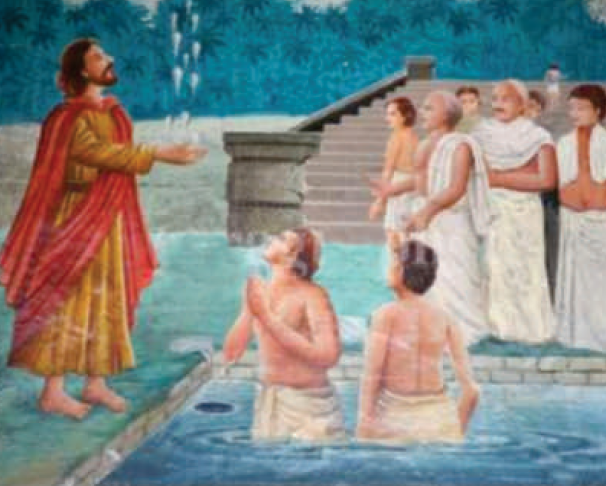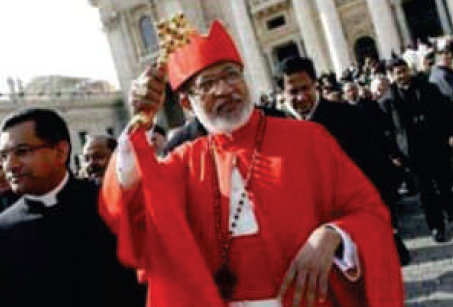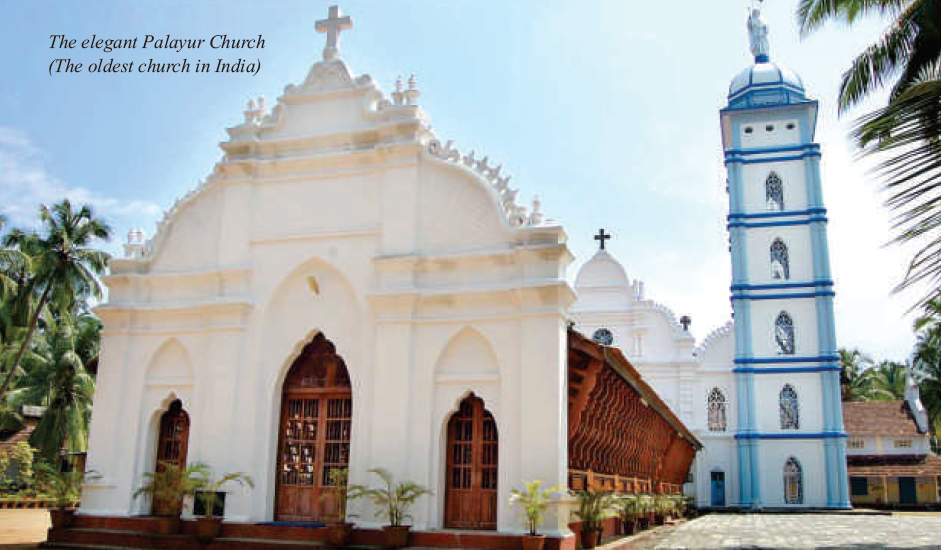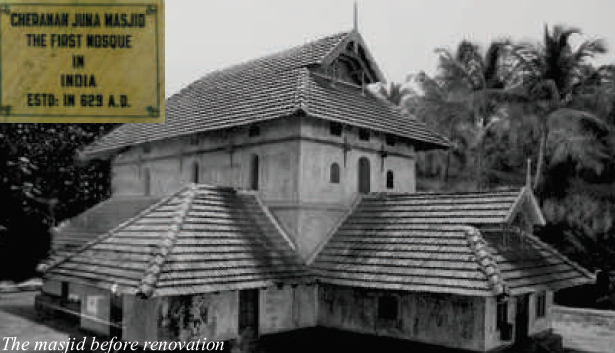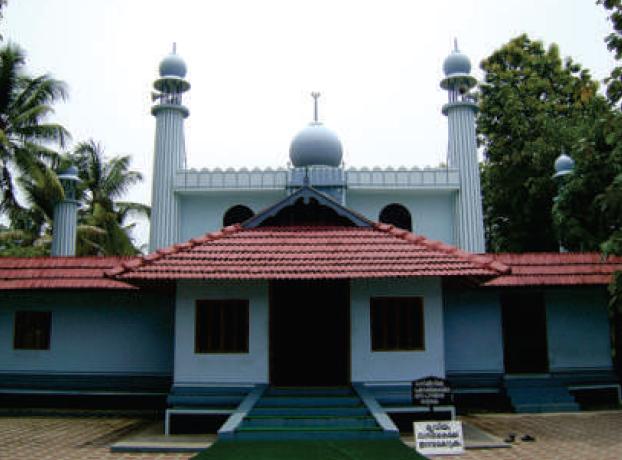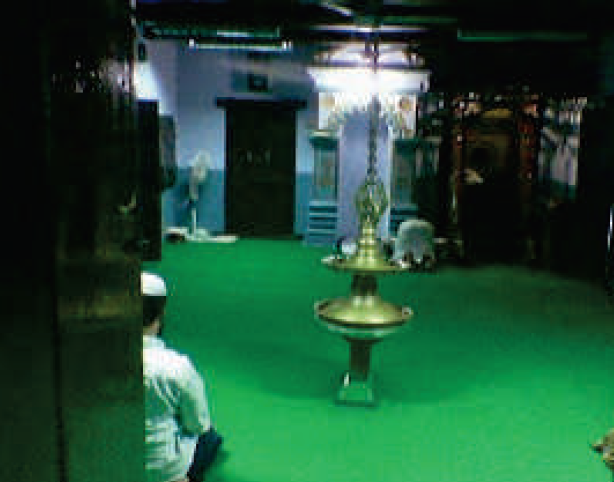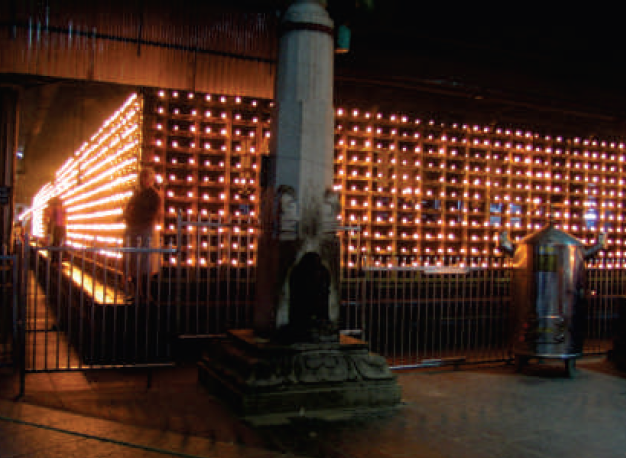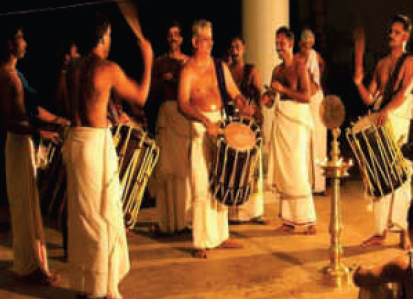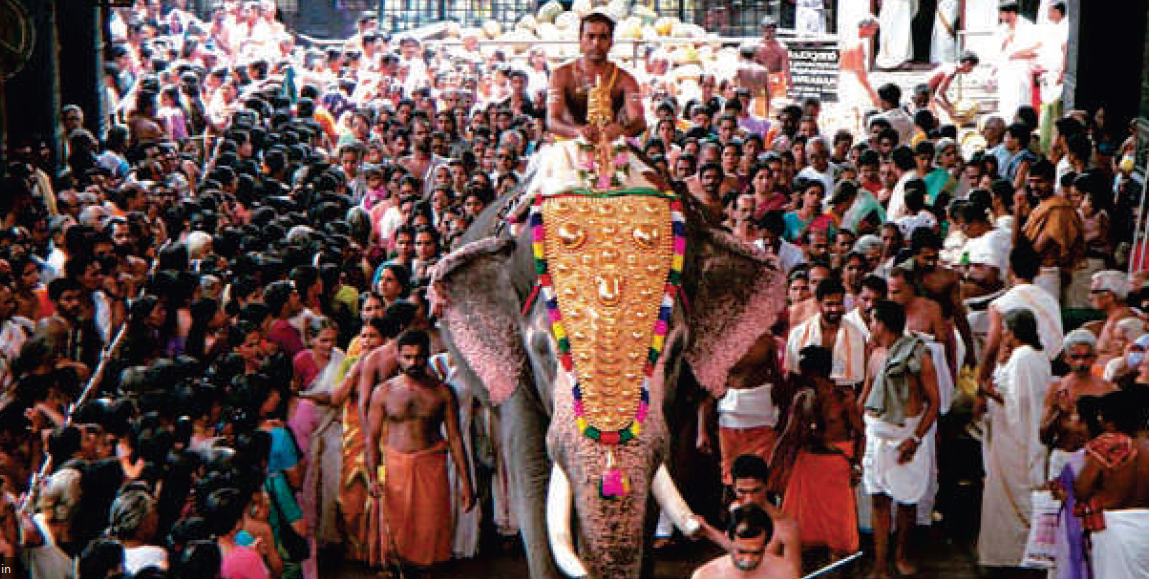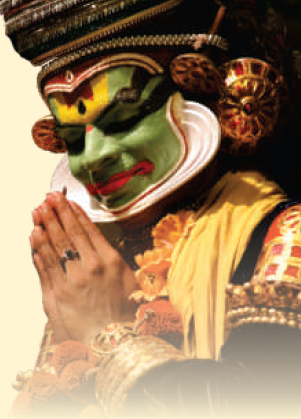Thrissur
| (3 intermediate revisions by one user not shown) | |||
| Line 9: | Line 9: | ||
|} | |} | ||
| − | + | ||
| − | + | ||
| − | + | ||
| − | + | ||
| − | + | ||
| − | + | ||
''' For Whom The Bells Toll ''' | ''' For Whom The Bells Toll ''' | ||
| Line 22: | Line 20: | ||
'' India Harmony '' Volume - 2 : Issue - 1, 2013 | '' India Harmony '' Volume - 2 : Issue - 1, 2013 | ||
| − | Thrissur : | + | '''Thrissur :''' |
| − | Guruvayur – Cheramun Juma Masjid – St. Thomas Church | + | |
| + | '''Guruvayur – Cheramun Juma Masjid – St. Thomas Church''' | ||
| + | |||
From across the seas, through the mists of | From across the seas, through the mists of | ||
time, there flowed rich cultural influences that shaped our destiny on earth, where | time, there flowed rich cultural influences that shaped our destiny on earth, where | ||
| Line 57: | Line 57: | ||
[[File: Annual Pilgrimage at Thrissur.png|Annual Pilgrimage at Thrissur|frame|500px]] | [[File: Annual Pilgrimage at Thrissur.png|Annual Pilgrimage at Thrissur|frame|500px]] | ||
| + | ==Cultural Capital of Kerala== | ||
An intrinsic part of picturesque Kerala, the | An intrinsic part of picturesque Kerala, the | ||
| Line 76: | Line 77: | ||
India and is located in Methala, Kodungallur | India and is located in Methala, Kodungallur | ||
Taluk in the state of Kerala. | Taluk in the state of Kerala. | ||
| − | + | ==St. Thomas== | |
But that was later....much later in time...almost six | But that was later....much later in time...almost six | ||
centuries earlier, in 52 A.D. to be precise, another | centuries earlier, in 52 A.D. to be precise, another | ||
| Line 89: | Line 90: | ||
[[File: The old port of Cranganoor.png|The old port of Cranganoor|frame|500px]] | [[File: The old port of Cranganoor.png|The old port of Cranganoor|frame|500px]] | ||
| − | + | ===Palayur=== | |
At that time, Palayur was a stronghold of the | At that time, Palayur was a stronghold of the | ||
Brahmins and also of Jews. He came to visit the | Brahmins and also of Jews. He came to visit the | ||
| Line 118: | Line 119: | ||
then promise to convert to his superior faith – | then promise to convert to his superior faith – | ||
Christianity!. | Christianity!. | ||
| − | + | ===Conversions=== | |
He then proceeded, in all seriousness, to perform | He then proceeded, in all seriousness, to perform | ||
this miracle (summoned the Holy Trinity, | this miracle (summoned the Holy Trinity, | ||
| Line 202: | Line 203: | ||
[[File: The Guruvayoor temple complex.png|The Guruvayoor temple complex|frame|500px]] | [[File: The Guruvayoor temple complex.png|The Guruvayoor temple complex|frame|500px]] | ||
| − | |||
St. Thomas, who was proclaimed 'The Apostle of | St. Thomas, who was proclaimed 'The Apostle of | ||
| Line 216: | Line 216: | ||
[[File: Elephants and pilgrims at Guruvayoor.png|Elephants and pilgrims at Guruvayoor|frame|500px]] | [[File: Elephants and pilgrims at Guruvayoor.png|Elephants and pilgrims at Guruvayoor|frame|500px]] | ||
| − | + | 2013 commemorated 60 years of | |
this sacred and historic event, and the devout will | this sacred and historic event, and the devout will | ||
once again flock in joyous veneration, in | once again flock in joyous veneration, in | ||
| Line 241: | Line 241: | ||
soil and germinated to grant the genesis of another | soil and germinated to grant the genesis of another | ||
faith…… | faith…… | ||
| − | + | ==Islam in Thissur== | |
[[File: The dress code at the temple.png|The dress code at the temple|frame|500px]] | [[File: The dress code at the temple.png|The dress code at the temple|frame|500px]] | ||
| Line 308: | Line 308: | ||
spirit of communal harmony that prevails in this | spirit of communal harmony that prevails in this | ||
picturesque land. | picturesque land. | ||
| − | + | ==Guruvayoor== | |
The three sacrosanct abodes of the Gods – | The three sacrosanct abodes of the Gods – | ||
Church, Mosque and Temple, symbolic of the | Church, Mosque and Temple, symbolic of the | ||
| Line 344: | Line 344: | ||
some 25 years ago, my husband and I landed up | some 25 years ago, my husband and I landed up | ||
Ancient oil lamp inside the masjid The oil lamps in the Guruvayoor temple | Ancient oil lamp inside the masjid The oil lamps in the Guruvayoor temple | ||
| + | |||
The Guruvayoor temple complex | The Guruvayoor temple complex | ||
here, loaded with enthusiasm, dressed as carefree | here, loaded with enthusiasm, dressed as carefree | ||
| Line 374: | Line 375: | ||
one of us had redeemed the honor of their | one of us had redeemed the honor of their | ||
religious faith! | religious faith! | ||
| − | + | ===Sri Kovil of the Guruvayur Sri Krishna Temple=== | |
| − | The "presiding" deity in the Sri Kovil of the | + | The "presiding" deity in the Sri Kovil of the Guruvayur Sri Krishna Temple, is Vishnu. He is |
| − | Guruvayur Sri Krishna Temple, is Vishnu. He is | + | |
currently worshipped according to routines laid | currently worshipped according to routines laid | ||
down by Adi Shankara and later written formally | down by Adi Shankara and later written formally | ||
| Line 422: | Line 422: | ||
pushing you to priestly purity even as you | pushing you to priestly purity even as you | ||
circumambulate its sacred pond in wonder! | circumambulate its sacred pond in wonder! | ||
| − | + | ===Sacred Guruvayoor tank or pond=== | |
The sacred Guruvayoor tank or pond, known for | The sacred Guruvayoor tank or pond, known for | ||
its ever blooming magical lotus flowers, was | its ever blooming magical lotus flowers, was | ||
| Line 454: | Line 454: | ||
compassion, caring and the cadences of a cosmic | compassion, caring and the cadences of a cosmic | ||
faith! | faith! | ||
| + | |||
| + | =See also= | ||
| + | [[St Thomas]] | ||
| + | |||
| + | [[Category:India|T | ||
| + | THRISSUR]] | ||
| + | [[Category:Name|ALPHABET | ||
| + | THRISSUR]] | ||
| + | [[Category:Places|T | ||
| + | THRISSUR]] | ||
Latest revision as of 14:57, 5 May 2023
This is a collection of articles archived for the excellence of their content. Readers will be able to edit existing articles and post new articles directly |
For Whom The Bells Toll
By Dr. Vinita Kaul Gardner
India Harmony Volume - 2 : Issue - 1, 2013
Thrissur :
Guruvayur – Cheramun Juma Masjid – St. Thomas Church
From across the seas, through the mists of time, there flowed rich cultural influences that shaped our destiny on earth, where teeming humanity mulled – over the tenets of munificent faiths!
They came from distant lands – these saviors of mankind – cloaked in the guise of merchants wanting to indulge in trade with the abundance of aromatic spices off verdant Kerala's coast. While they carried away abundant harvests of spices culled from the soil of the earth, destined to flavor exotic dishes around the world, they left an abundant slice – of their fascinating culture – here to enrich our part of the earth. And sow the seeds of a fulsome faith which flourished to nurture a thousand lives…..and then some more….
The earth that received their munificent beliefs
was none other than the town of Thrissur, standing
stoic sentinel at the junction of a tremendous triad
of faiths – Islamic, Christian and Hindu - brought
by the apostles of peace and the unifiers of
mankind, for the realization of an impossible
dream……that men of all faiths should live in
complete harmony as God decreed…..and that
their women should nourish such a creed!
Contents |
[edit] Cultural Capital of Kerala
An intrinsic part of picturesque Kerala, the sobriquet of “God's Own Country” acquires an additional meaning here contextually! For Thrissur, which has been dubbed as the Cultural Capital of Kerala, because of its cultural, spiritual and religious leanings throughout history, is located approximately two and a half dozen km from both the famous Guruvayur Temple, a Mecca for devout followers of the Hindu faith and St Thomas's Church, perpetrating the Christian faith. In addition, it plays sacred host to the oldest mosque outside of Arabia – the Cheraman Juma Masjid – located just a few minutes' drive from the town of Thrissur and dating in antiquity to 629 AD. Built by Malik lbn Dinar, it is believed to be the very first mosque constructed in India and is located in Methala, Kodungallur Taluk in the state of Kerala.
[edit] St. Thomas
But that was later....much later in time...almost six centuries earlier, in 52 A.D. to be precise, another apostle of a devout faith – Christianity – built the famous St. Thomas Syro-Malabar Catholic Church at Payalur, in Thrissur district. St. Thomas, one of the twelve apostles of Jesus Christ, travelled by boat, as was customary in those days, from Kottakavu or Crangannur, now called Kodungallur (Mussiris) and landed at Palayur on the picturesque west coast of India.
[edit] Palayur
At that time, Palayur was a stronghold of the Brahmins and also of Jews. He came to visit the Jewish merchants at Palayur at "Judankunnu" (meaning the hill of Jews) and to preach the Christian gospel.
An unusual sight met his bemused gaze upon landing at Palayur! Historical legends record that St. Thomas witnessed the sight of Hindu Brahmins- after their ritualistic morning ablutions in the local tank – offering prayers by chanting mantras and hymns to god in the form of Argyam or Thapanam (water held in the palms) in aINDIA HARMONY VOLUME - 2 : ISSUE - 1, 2013 reverential offering to the Sun God! This unique practice was also believed to have been followed in the ancient Harappan and Persian cultures!
Amused by the sight of water being thrown up by the Brahmins from the palms of their hands and then falling back into the tank, he challenged them that he would imitate their practice, with one significant difference! Reiterating that his God would accept the water thus offered by him, without letting it fall back, he exhorted them to then promise to convert to his superior faith – Christianity!.
[edit] Conversions
He then proceeded, in all seriousness, to perform this miracle (summoned the Holy Trinity, completed the sign of the Cross and threw water held in his palms up into the air, which remained still in the air at a height) and with this miracle he converted a number of Brahmins and Jews in Palayur to Christianity. Thereafter he baptized the converts in a nearby water tank. The disbelievers migrated to Vembanad to purify themselves!
Following the migration of the Hindu Brahmins from Palayur, the Church was built incorporating the old Hindu temple, which was deserted. An aesthetic fusion of an intrinsically Hindu architectural style in respect of ornamentation, combined with a Persian Church plan, the roof of the church raises like a tower above the nave. The approach or entrance is like a Hindu style mandapa (in Indian architecture it is a pillared outdoor hall or pavilion for public rituals).
An Italian missionary built the new church around the small old teak wood church after taking due permission from the locals who were not only superstitious but also sentimental about retaining the old Church! However, after the church was fully completed and duly sanctified through sermon and ceremony, the old wooden structure was abolished. The original altar lovingly consecrated by St. Thomas however, is still retained!
Which comes to life when thousands of devotees every year, during the Lenten season, without any caste distinction, joyously participate in the Palayur Mahatheerthadanam or Great Pilgrimage – a major festival held every year at the venue of the church - under the auspices of the Syro- Malabar Archdiocese of Thrissur.
This important festival, which lasts for two days and is held during the Lenten season, bears a striking similarity to the Hindu festival held at Trichhur district town, 28 km away, on the same days, with a colorful fanfare of pageants, orchestra and pyrotechnics! An ambience of great revelry prevails, with entire families dressed in their Sunday best, enjoying the festivities wholeheartedly!
The elegant Palayoor church, the oldest (Romo- Syrian) Church in India and called an Apostolic Church credited to the Apostolate of St. Thomas, who commenced his conversions here, was part of the seven churches that he established in India. Of the other six, only Parur in the Syro-Malabar Archdiocese of Ernakulam and Niranam under the Orthodox Syrian Church (Devalokam Aramana) can claim continuity, along with Palayoor Church, the others having gone through several locational changes subsequently!
In a strange irony of fate, a valuable document
called 'Grandavariola' kept by a local Brahmin
family (who had moved out from Palayur during
the preaching), is the one that unequivocally
testifies to the date of the gospel work of St.
Thomas! The document states:
Kali year 3153 (52 AD) the foreigner Thomas Sanyasi came to our village (gramam) preached there and therby causing…
St. Thomas, who was proclaimed 'The Apostle of India' by the Holy See, stayed in India for 17 years, 4 years in Sindh (now in Pakistan), about 6 years in Malabar and 7 years at Mylapuram in Tamil Nadu! According to tradition, St. Thomas attained martyrdom at St. Thomas Mount in Chennai and is buried on the site of San Thome Cathedral. His skeletal remains were brought to India in 1953 by Cardinal Tisserant.
2013 commemorated 60 years of this sacred and historic event, and the devout will once again flock in joyous veneration, in thousands from various parts of the world, to this famous Mount in Chennai, cutting smoothly across barriers of countries, caste and creed! Following the famous H.G. Wells phenomena of moving backwards in time, propounded in The Time Machine, let us now back-track swiftly to another time, another place, where the seeds of another creed were swiftly and surely scattered in the fertile Kerala soil and germinated to grant the genesis of another faith……
[edit] Islam in Thissur
Kerala Vyasan Kunhikuttan Thampuran firmly believes that an old Buddha temple was gifted to the Muslims to establish a mosque! Since ancient times, trade relations between Arabia and the Indian subcontinent were active. Even before Islam had been established in Arabia, Arab traders visited the Malabar region, which was a major link between the ports of South and Southeast Asia, and rich in the abundant production of aromatic spices!
With the advent of Islam, the Arab merchants became carriers of the new religion and they propagated it wherever they went. Numerous Indians living in the coastal areas of Kerala accepted the principles of this religion and converted to Islam. The Brahmin King Cheraman Perumal was the first Indian who converted to Islam based on a popular historical event.
When a group of Prophet Muhammad's Sahaba (companions) visited Kodungallur, the Chera ruler witnessed a miraculous happening — the sudden splitting of the moon, the celebrated miracle of Muhammad — and learned on inquiry that this was a symbol of the coming of a Messenger of God from Arabia!
Soon after, Perumal traveled to Makkah, where he embraced Islam and accepted the name Thajudeen. On his way back to India, however, after a supposedly arduous journey, he unfortunately died at Salalah in the Sultanate of Oman! On his deathbed, in a dramatic gesture, he is said to have authorized some of his Arab companions to go back to his kingdom to spread Islam! Accordingly, a group of Arabs led by Malik Bin Deenar and Malik bin Habib, arrived in north Kerala and constructed a Masjid at Kodungalloor.
The construction of the Masjid thus sponsored by King Cheraman was, fittingly enough, named the Cheraman Juma Masjid. The mosque, which is built in the traditional Hindu architectural style using brass oil lamps, symbolizes communal harmony!
While the rosewood pulpit, from where the imam recites the Friday Jumu'ah, is covered with carvings and a block of white marble in the mosque is believed to have been brought from Makkah, the Kodungalloor mosque is believed to have an ancient oil lamp which always burns and which is believed to be over a thousand years old! People of all religions bring oil for the lamp as offering. This is one of the few mosques in Kerala which allows entry for people of other religions, thereby reaffirming the spirit of communal harmony that prevails in this picturesque land.
[edit] Guruvayoor
The three sacrosanct abodes of the Gods – Church, Mosque and Temple, symbolic of the tenets of three major faiths – stand magnificent and mute testimony to the spirit of enlightenment and the homogenous existence of the communities of three diverse faiths. Completing this triad of religious virtuosity is the renowned Guruvayoor Temple, a Hindu temple dedicated to God Krishna, located in the town of Guruvayur in Kerala, India.
One of the most important places of worship for Hindus of Kerala and often referred to as "Bhuloka Vaikunta" which translates to the "Holy Abode of Vishnu on Earth", the idol installed at Guruvayur Sri Krishna Temple represents a form of Krishna with its four arms carrying the conch Pancajanya, the magical discus with serrated edges Sudarshana Chakra, the mace Kaumodaki and a lotus with a Holy basil garland. This idol represents the majestic form of god Vishnu as revealed to Vasudeva and Devaki around the time of Krishna; hence Guruvayur is also known as "Dwaraka of South India”!!
Heavily loaded with religiosity, with myth and legend bolstering it further so that it assumes the impressive proportions of a formidable faith, a pilgrimage to the South is not complete unless one pays obeisance here! And so it was that on a whirlwind cultural odyssey of this divine region some 25 years ago, my husband and I landed up Ancient oil lamp inside the masjid The oil lamps in the Guruvayoor temple
The Guruvayoor temple complex here, loaded with enthusiasm, dressed as carefree tourists are wont to be, in colorful (but modest) western attire!
Unaware that an extremely strict dress code prevailed, for both men and women, for entry into this sacred temple, the emphatic injunction of the solemn-eyed priest that my husband would have to wear a “mundu” around his waist and go in bare-chested, drew a horrified response from him! “Not on your life”, he declared stubbornly, “I haven't bared my chest in front of my father, I'm not going to do it in front of a bunch of strangers”! All my cajoling proved to be of no avail and finally, shrugging my shoulders in a gesture of defeat, I deftly wound a turmeric yellow half-sari round my waist and entered the temple with a new-found respect!
Bowing my head in reverence before the deity of the Guruvayur Temple, which is believed to be 5,000 years old and considered to be unique as it is carved out of Patalanjana stone and considered to be extremely sacred by the Hindus, I duly exited the holy precincts. Much to the amused gaze of my husband and the highly approving looks of the young priests,relieved that at least one of us had redeemed the honor of their religious faith!
[edit] Sri Kovil of the Guruvayur Sri Krishna Temple
The "presiding" deity in the Sri Kovil of the Guruvayur Sri Krishna Temple, is Vishnu. He is currently worshipped according to routines laid down by Adi Shankara and later written formally in the tantric way, the inter-religious spiritual movement that arose in medieval India, by Cennas Narayanan Nambudiri (born in 1427 A.D.). The Cennas Nambudiris are the hereditary tantris of the Guruvayur Temple.
The Krishna temple in the town of Guruvayoor in Kerala is one of the five famous Krishna\Vishnu temples in India, the other four being Jagannath Puri in Orissa, Venkatachalapati in Andhra Pradesh, Nathdwara in Rajasthan and Dwaraka in Gujarat. Of course there are many other famous ones of Vishnu as well as of Krishna but these are considered to be the most popular.
The life of the people in this town literally revolves around this temple! So much so, in fact, that they wend their way there at the unearthly hour of 3 a.m. to witness the ritual anointing of their Guruvayoorappan or “God of Guruvayoor” with til oil, then rubbed with special herbal powder, known as “vaka” for that extra shine, before he is reverently bathed! Then water from the temple, consecrated with mantras, is poured over the idol for his ritual bath. This holy water is then eagerly drunk by the devotees since it is said to contain a little of the miraculous properties of the black antimony stone of which the idol is made. Seeking salvation for our sins and our souls, what won't we mere mortals do!
Whatever be your particular propensity of faith, many avenues lead to its munificent and multiple manifestations here on earth – in myth, legend and reality – the muezzin calling the faithful to prayer, the priest from the pulpit intoning injunctions of morality or the sonorous chant of Vedic mantras from within the precincts of the implacable Guruvayoor God pushing you to priestly purity even as you circumambulate its sacred pond in wonder!
[edit] Sacred Guruvayoor tank or pond
The sacred Guruvayoor tank or pond, known for its ever blooming magical lotus flowers, was where Lord Siva emerged out of the sacred tank and revealed to the Pracetas (the ten sons of the mythical King Prajinabarhis and his wife, Queen Suvarna), the “Rudragitam” – a hymn in praise of Vishnu! Advising them to chant the hymn with all their heart to get their wishes fulfilled – of becoming “the king of all kings” - the princes won the favour of Vishnu after rigorous tapasya for 10,000 years under the tank by chanting this beautiful hymn!
The fulfillment of a wish, the answer to a prayer, the tangible translation of a “tamanna” into reality - these are some of the benevolent blessings of BELIEF that are bestowed upon the trusting and the true, the devout and the dutiful, the blessed and the benign –weaving the warp and weft of the tapestry of India's communal conviviality with consummate finesse, with the tensile cords of compassion, caring and the cadences of a cosmic faith!

